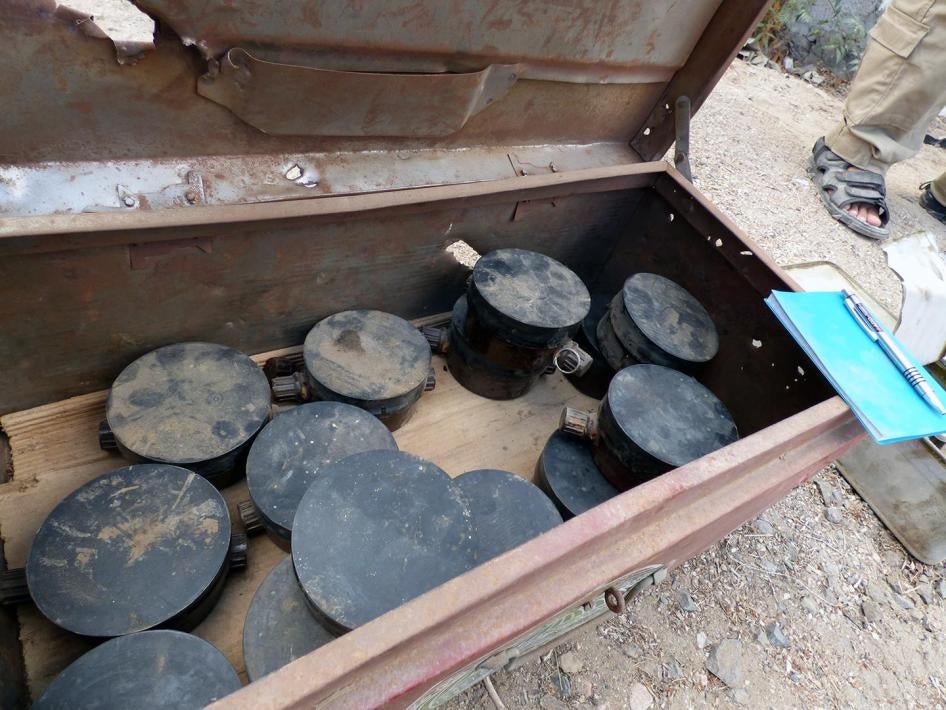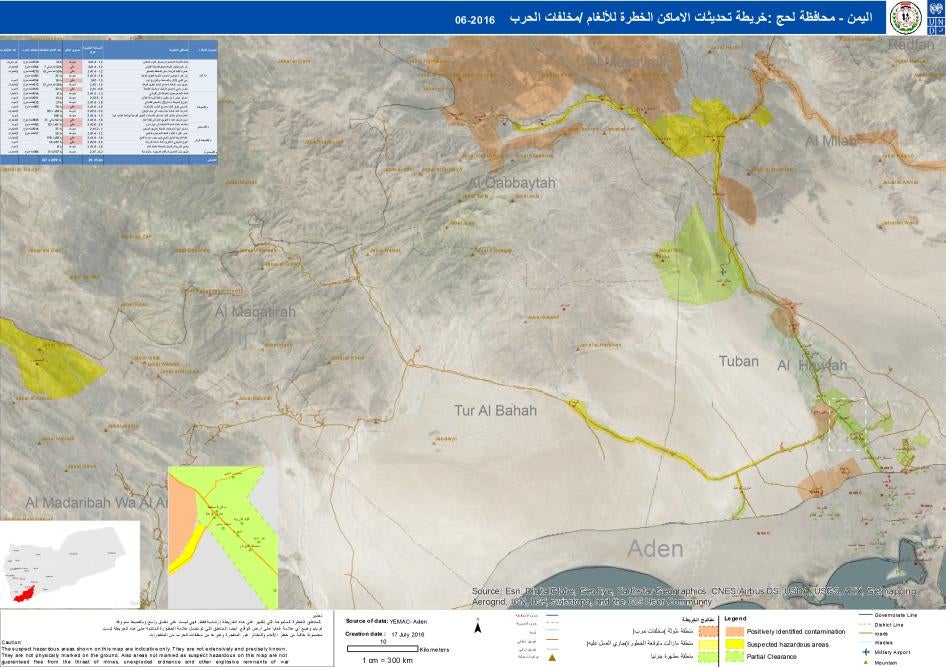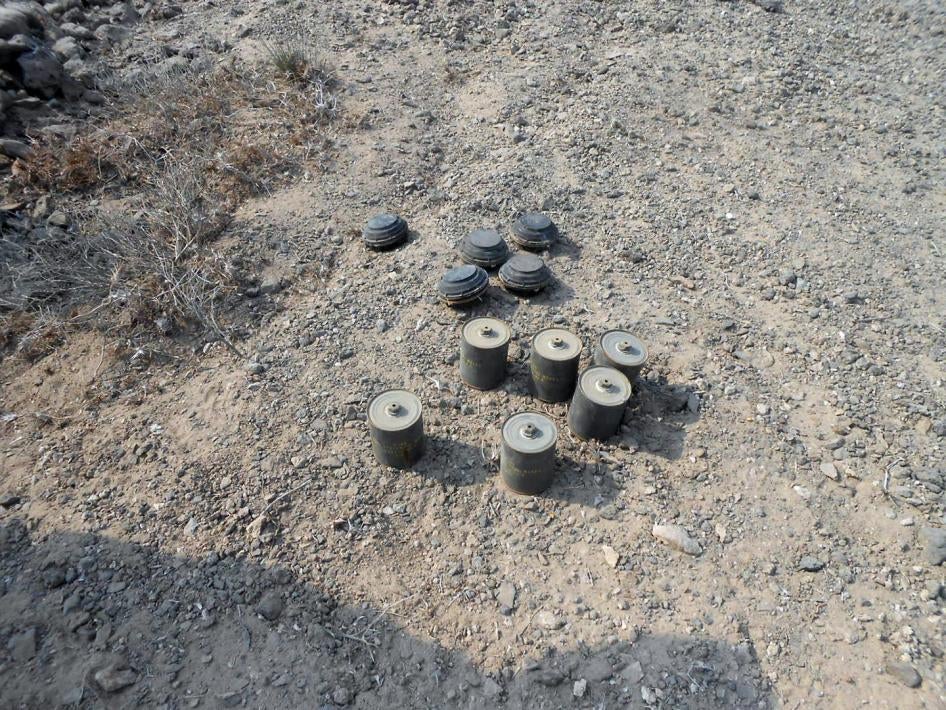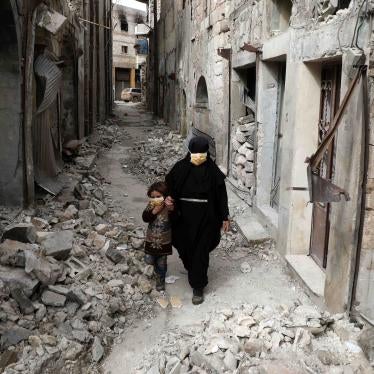Houthi-Saleh forces have also made and used improvised antipersonnel mines, Human Rights Watch said. In Yemen, antivehicle mines or other explosives are sometimes triggered by an individual using a pedal a few meters away. In February 2017, the Yemen Executive Mine Action Center (YEMAC) found and cleared improvised mines on civilian roads near the port city of Mokha in Taizz governorate, from which Houthi-Saleh forces had recently withdrawn.
The Houthi-Saleh forces use of antipersonnel landmines violate the laws of war and individuals involved are committing war crimes, Human Rights Watch said. Houthi-Saleh forces have also used antivehicle mines indiscriminately in violation of the laws of war and failed to take adequate precautions to avoid civilian casualties.
In an April 2 response to a Human Rights Watch letter regarding recent landmine use, Yemen’s Foreign Affairs Ministry in Sanaa, controlled by the Houthis and Saleh’s General People’s Congress Party, said the Sanaa-based authorities are “vigilant in abiding by [their] commitments” under the Mine Ban Treaty. The ministry denied that Houthi-Saleh forces had used antipersonnel landmines or that the Sanaa-based Defense Ministry stockpiles antipersonnel mines. It said that “armed factions and terrorist groups” have produced and used improvised landmines, often referred to as improvised explosive devices (IEDs) or booby traps. Victim-activated IEDs fall under the definition of an antipersonnel landmine and are prohibited by the Mine Ban Treaty.
The ministry also said that after the conflict ends, the Sanaa-based authorities are prepared to create a committee to investigate the use of landmines in Taizz and to investigate any new information or documentation on the use of antipersonnel mines elsewhere, and to “take the necessary steps in accordance with national laws and regulations and its international obligations.”
The Houthi-Saleh authorities should take immediate steps to ensure that affiliated forces cease using antipersonnel mines, destroy any antipersonnel mines they possess, and appropriately punish those using these indiscriminate weapons, Human Rights Watch said.
International assistance is urgently needed to equip, train, and assist clearance personnel to systematically survey, clear, and destroy Yemen’s mines and explosive remnants of war, Human Rights Watch said. International donors should also urgently assist victims of landmines and explosive remnants of war in Yemen. Appropriate compensation, assistance, and support should be provided to those wounded by mines, or to the families of those killed. Assistance should include medical care, prosthetics, and ongoing rehabilitation.
Houthi-Saleh forces are not the only party to the Yemen conflict using landmines. Al-Qaeda in the Arabian Peninsula (AQAP) has used landmines, particularly improvised mines. After the Saudi-led coalition captured the eastern port city of Mukalla from AQAP in April 2016, large stocks of explosives were found, including 116 antipersonnel mines in Hadramawt, which were believed to have belonged to the armed group. Mine clearance personnel also told Human Rights Watch that AQAP laid landmines in Abyan governorate.
The Yemen Executive Mine Action Center’s southern branch reportedly found and destroyed 65,272 landmines, including 20,807 antipersonnel landmines, between July 21, 2015 and March 2, 2017 in Aden, Abyan, Lahj, al-Dhale, and Taizz. These include both landmines cleared by demining personnel and stocks found in weapons stores.
Since 2015, about 20 YEMAC staff members have been wounded or killed during clearance operations. Brig. Gen. Sheikh Zaid Thabet, who heads demining efforts in Marib, said his team lacks proper equipment: “Some of them work without shoes, barefoot… We lost six members of our team and more than 10 were wounded in different accidents.”
In Aden, YEMAC and the Yemen Society for Landmine Survivors said that all support from YEMAC’s Sanaa headquarters ceased when the Houthis took control of the capital.
“The Houthi-Saleh forces’ use of banned landmines is only going to prolong Yemen’s eventual recovery from this bloody conflict,” Goose said. “Governments should condemn antipersonnel landmine use and work with Yemeni officials to ensure that those who used them are held accountable.”
Human Rights Watch documented 10 incidents in which landmines killed or wounded people in Sanaa, Marib, Aden, or Taizz governorates.
Sanaa Governorate
Houthi-Saleh forces control most of Sanaa governorate. The eastern Nihm district, on the border of Marib governorate, has been one of the conflict’s static front lines. Brig. Gen. Thabet, who heads demining efforts in Marib and nearby areas under Hadi government control, said that his team began demining efforts in Nihm in March 2016, gradually expanding their operations as Houthi-Saleh forces withdrew from different areas.
January 22 and 23, 2017, Nihm District
In January, Thabet’s demining team conducted clearance operations in Nihm district, Sanaa, in an area from which Houthi-Saleh forces had only recently withdrawn. On January 22, a team member, Muhammad Abo A’lba, stepped on a landmine and was killed. The next day, his colleague, Abo Mursi, stepped on an antipersonnel landmine and lost both his legs. The area was not known to be mined prior to the current conflict.
May 24, 2016, Al-Saad Village, Nihm District
On May 23, 2016, Saleh Ahmad, in his mid-forties, returned to his home in Al-Saad village in Nihm district, Sanaa with his wife, two daughters, and two sons. His entire village, about 60 families, were displaced from the area in 2015 when Houthi-Saleh forces advanced, he said. He and his family returned the day after Houthi-Saleh forces withdrew “because we couldn’t afford to stay out of our home anymore.”
The next day at about the time of the early evening prayer, his wife, Rawiya al-Dahak, 30, went to bring back the sheep from grazing. Ahmad said he heard an explosion:
I ran to the place [about 300 or 400 meters from our home], and found my wife with her right leg completely missing. She was unconscious and bleeding. Her clothes were torn. ... I carried her to the closest health center.
When Ahmad’s eldest son, Muhammad Saleh, 23, heard about the accident, he went to check the area on foot. Another mine exploded. “I was not there,” Ahmad said. “The neighbors called me and they told me that I lost my beloved son.”
A few days later, a demining team cleared about 13 antivehicle mines from around Ahmad’s home. Saad believed a mine attached to a large explosive charge wounded his wife and that another killed his son, due to the severity of the burns on his son’s body and the force of the explosion that wounded his wife. Antivehicle mines that have been modified to explode when a person is nearby are considered antipersonnel mines prohibited by the Mine Ban Treaty.
In 2017, the UN Panel of Experts on Yemen reported that Houthi-Saleh forces were using victim-activated IEDs that deployed antivehicle mines as the main charge in Taizz. The UN Panel found that until these mines were defused, they prevented civilians from returning.
Displaced people have a right to return home safely as soon as the reasons for their displacement cease to exist. The laws of war obligate warring parties to facilitate their safe return.
Two days after Saad’s son was killed and his wife wounded, another man living near the village of Al-Saad detonated an improvised mine, losing both his legs, Ahmad said. About a week later, a few kilometers from the village, 10 sheep were killed by an improvised mine, according to Ahmad.
Marib Governorate
Houthi-Saleh forces controlled most of Marib between May and October 2015, laying landmines as they withdrew, deminers and local activists said.
General Thabet said that he and several other deminers had destroyed 510 antipersonnel mines on February 6, 2016, and another 350 about a month later, in addition to 3,390 improvised landmines. Marib remains heavily contaminated with mines, he said.
Ali Al-Tam, director of the Civil Protection Organization, a Marib-based group that has documented civilian victims of landmines, said antipersonnel mines, including improvised mines, had been found in civilian-populated and agricultural areas after Houthi-Saleh forces withdrew, including the districts of Marib City, Harib, al-Abadiya, Sarwah and Majzer. These areas were not known to be mined prior to the current conflict.
Saleem Allaw, the HOOD Team Coordinator in Marib, al-Jawf and al-Bayda, shared a list of names, ages, and dates of people killed or wounded by landmines in Marib and al-Jawf governorates since October 2015. HOOD reported that 80 people were killed, including two women and eight children, and 136 wounded, including four women and 14 children, by landmines in the two governorates.
March 1, 2016, Al-Jufina Farming Area, Marib City District
At about 1:30 p.m. on March 1, 2016, Ali al-Ansi, 35, stepped on a landmine while he was working in an orange grove in Marib, which Houthi-Saleh forces had controlled before withdrawing in late 2015. He said he was returning from lunch with his wife and two daughters: “I walked inside [the grove]. Then, suddenly I heard the blast. I didn’t see anything except the dust flying over my head. I looked at my legs, and saw my right leg had been blown apart.”
Other farm workers took al-Ansi to a hospital, where a doctor amputated his right leg. He stayed at the hospital for four days. Hospital staff then asked al-Ansi to return home as they needed space for other patients.
A few days later, al-Ansi guided deminers to the location where he was wounded. The team cleared four small mines. Al-Ansi said they were “black-greenish” and about “the size of a can.” Human Rights Watch researchers showed Al-Ansi a selection of photos depicting landmines used recently in Yemen, and he said they looked like a GYATA-64 antipersonnel mine.
Al-Ansi has been unable to work since his injury and depends on support from family members.
The orange grove was not known to be mined before the Houthi-Saleh forces occupied it.
Aden Governorate
In March 2015, Houthi-Saleh forces entered Aden, eventually occupying nearly half of the city’s districts, including Sheikh Othman, al-Buraika, Krater, Khormaksar, and Dar Saad. They laid antivehicle and antipersonnel landmines as they withdrew from the city in July 2015, according to YEMAC and security officials.
Two fighters from Aden lost limbs after stepping on antipersonnel mines in the Khormaksar and al-Basateen neighborhoods in July 2015, soon after Houthi-Saleh forces withdrew. They said the areas were heavily mined when the forces entered. The neighborhoods were not known to be mined before the current conflict.
Yemeni mine action officials began emergency clearance of landmines and explosive remnants of war almost immediately after Houthi-Saleh forces withdrew from Aden. YEMAC officers and a demining activist said that since that time antipersonnel mines have been cleared from 11 neighborhoods: Al-Basateen, Green City, and Al-Luhoom neighborhoods in Dar Saad district; al-Emad and al Masa’abi neighborhoods in Sheikh-Othman district; Bir Fadhl and Ja’ulaa neighborhoods in al-Mansoora district; Bir Ahmad and Ras Amran in al-Buraika district; and al-A’areesh and al-Nasser neighborhoods in Khormaksar district.
Since Houthi-Saleh forces withdrew more than a year-and-a-half ago, YEMAC has been clearing landmines from the city. The National Demining Training Center showed Human Rights Watch photos of an antivehicle mine and two PPM-2 antipersonnel mines discovered and cleared from a heavily frequented road in al-Emad, north of Sheikh Othman district, on February 1. On March 29, YEMAC removed six more PPM-2 antipersonnel mines next to one of Aden’s main highways in Khormaksar, which they said were laid by Houthi-Saleh forces.
Yemen’s Health Ministry, currently based in Aden, told Human Rights Watch in February that soon after Houthi-Saleh forces withdrew from the city, Aden’s hospitals were receiving about seven to eight people wounded by landmines each week and that they have continued to receive landmine victims.
February 6-8, 2016, Al-Naser Neighborhood, Khormaksar District
On February 6, 2016, a car carrying a family of four struck a landmine, killing the father and two children, according to YEMAC.
YEMAC sent a team to the site, which cleared three antipersonnel mines and an antivehicle mine on the first day and eight “German-made” antipersonnel mines on the second.
On the third day, Abdo al-Ashwal, a 45-year-old YEMAC deminer, was working in the area:
“I took out a mine, but we had a technical problem with the detector [that YEMAC was using] … The detector didn’t detect the mine that was under a [cylinder] block. I stepped on the block. Then I lost my consciousness.”
Team members took al-Ashwal to a nearby hospital. He lost one leg and stayed in the hospital for 22 days. Al-Ashwal, who is married with five children, said he can no longer work and has been unable to provide an income for his family. He has not received any compensation.
September 17, 2015, Bir Ahmad Neighborhood, Al-Buraika District
At about 10 a.m. on September 17, 2015, Yassin Omar, a 33-year-old from Aden, drove a construction vehicle over a small dirt mound at a farm where he was working. The farm was near Bir Ahmad military camp, which had been controlled by Houthi-Saleh forces prior to their withdrawal from Aden. His vehicle triggered a landmine explosion that threw him out of the vehicle: “I tried to run, but I couldn’t, I didn’t know that I had lost my right leg, so I crawled for five or six meters. Then I lost consciousness.”
Omar, who has three children, said he had been worried about taking the job at the farm because he had heard people had been wounded by landmines in the area after Houthi-Saleh forces left. He said he had been assured the area was safe.
July 24, 2015, Al-Basateen Neighborhood, Dar Saad District
At about 9 a.m. on July 24, 2015, Muhammad Hansh, 43, entered al-Basateen neighborhood with other men from Aden fighting Houthi-Saleh forces. He stepped on a landmine: “I saw my leg at that moment – fragmented, chopped off.” He was taken to a hospital in Sheikh Othman, where his right leg was amputated.
July 14, 2015, Al-Nasser Neighborhood, Khormaksar District
Sameer Derwish, 42, a plumber and a builder, joined local forces fighting Houthi-Saleh forces after they entered Aden. On July 14, 2015, he and a group of fighters came under fire in Khormaksar district. He said: “[The Houthis] forced us to take a path which is for civilians. There were some houses there, but they were empty because people left when the Houthis were controlling the area, so I walked and stepped on a landmine.”
Derwish said the mine was an antipersonnel mine, and that he saw other mines next to it after it exploded, including two small antipersonnel mines and “one big one, for tanks”. “I didn’t lose consciousness. … I was asking those around me, ‘What happened? What happened?’ They already saw that my leg was gone completely, but they didn’t say anything, they didn’t want to tell me.”
Derwish was kept in hospitals in Aden for about three months before being transferred abroad for rehabilitation and to get a prosthetic limb. Derwish, who is married and has six children, said, “I was working [before the war], my income was great, I was healthy, but now, I have no work.”
The area where Derwish was wounded is not believed to have been mined before the current conflict.
Taizz Governorate
In September 2016, Human Rights Watch documented the use of landmines by Houthi-Saleh forces in Yemen’s third-largest city, Taizz, investigating the cases of five people who had been maimed by antipersonnel mines between March and June 2016.
Taizz city and Taizz governorate have had heavy ground fighting throughout Yemen’s two-year-long war. In late 2016 and early 2017, coalition-backed forces affiliated with the Hadi government began advancing up Yemen’s western coast, eventually pushing the Houthi-Saleh forces out of the port city of Mokha in Taizz governorate.
YEMAC quickly began demining areas in Mokha from which Houthi-Saleh forces had retreated. YEMAC said that in February it had cleared and destroyed 770 mines from Bab al-Mandab district, about 75 kilometers south of Mokha, including about 150 mostly PPM-2 antipersonnel mines.



















